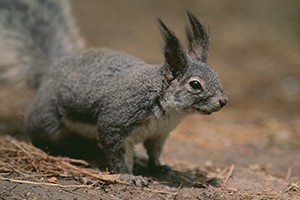By Andrew Marx, Masters student, Wildlife Ecology & Conservation
Imagine a remote island, its citizens valiantly trying to survive while besieged by foreign invaders and catastrophe. This was the story presented this week by Dr. John Koprowski at the Wildlife Ecology and Conservation department’s seminar. Except that instead of people, Dr. Koprowski discussed the story of the Mount Graham red squirrel, an isolated species in the Pinaleño Mountains facing the challenges of invasive competitors, human impacts, wildfires, destructive insects, and more.
Surrounded by desert valleys, the high elevations of the Pinaleño Mountains in southeast Arizona are home to forests that serve as an oasis in a desert. Or, perhaps more appropriately, as an island in the sky. It’s these forests that the Mount Graham red squirrel call home, and it’s this isolation that has led not only to their rise as a unique sub-species, but also to the severity of the dilemmas they face as they continue to exist.
A professor at the University of Arizona, Dr. Koprowski, started his research on the Mount Graham red squirrel in 2000. He soon found that his experiences working with this species would be shaped by events that occurred long before his arrival, starting with the discovery of the species in the late 1800’s. Eventually, its population declined to the point where many considered it to be extinct. Then, in the early 1970’s, it was rediscovered, which led to its being listed as a threatened species in Arizona, and eventually as a federally endangered species in the late 1980’s. Throughout this history of the Mount Graham red squirrel, numerous events took place that impacted the species. Work undertaken by Dr. Koprowski and his associates seeks to understand the consequences of these events and how to better manage squirrel populations.
One of the earliest events, prior to the Mount Graham red squirrel’s assumed extinction, was the introduction of Abert’s squirrels in the Pinaleño Mountains during the 1940’s by the Arizona Department of Game and Fish. Abert’s squirrels, being much larger than the Mount Graham red squirrel, were introduced in hopes of increasing hunting opportunities for people living in the region. At the time, it was believed that the Abert’s squirrel would make use of different habitat from the Mount Graham red squirrel. However, Dr. Koprowski’s work found the opposite to be true; there is significant overlap in the core areas used by individuals of each species, and moderate overlap in their overall home ranges. Currently, efforts are now being focused on removing the Abert’s squirrel in some areas to assess the level of impact this invasive species has on the native species.

In the period following the rediscovery of the Mount Graham red squirrel, the University of Arizona became interested in establishing an observatory on Mount Graham. Despite concerns about the impact of an observatory on the Mount Graham red squirrel, as well as concerns from local tribes that consider the land sacred, three telescopes were eventually constructed as part of the Mount Graham International Observatory. Dr. Koprowski and his colleagues have examined potential impacts that the resulting road infrastructure may have on squirrels. In particular, they monitored squirrels to determine if the roads acted as a barrier to movement, and concluded that this was not the case. Additionally, they quantified how noise from vehicles on the roads propagates through the landscape to identify areas with high and low levels of noise pollution. They found that areas with high levels of noise do have a negative impact on the presence of squirrels.
A significant effort has also focused on how the Mount Graham red squirrel responds to habitat fragmentation resulting not only from wildfires, but also from several species of defoliating insects. Roughly 45% of the canopy cover and live tree density has been lost in the region and understanding how this affects the Mount Graham red squirrel is an important factor in managing for its survival. To that end, Dr. Koprowski’s research examined to what degree the squirrels are using these defoliated areas, and how well they survive when they do use them. Using radio telemetry, Dr. Koprowski determined that Mount Graham red squirrels using these areas were less likely to survive relative to their counterparts in areas with higher canopy cover. The primary culprit for decreased survival was avian predators. Despite this, the squirrels counterintuitively continue to fall in the trap of making high use of these areas.
With a better understanding of the Mount Graham red squirrel and its past, Dr. Koprowski’s work shifts to the future of the species and the challenges it might face. In particular, he is interested in identifying the effects of climate change on population dynamics. Not only does climate change have the potential to shift or modify the habitat these squirrels prefer, but it also may affect their ability to store and maintain seeds for later use. The Mount Graham red squirrel has persisted in spite of numerous challenges, but that may not always be the case. New challenges like climate change continue to arise, and the future of this species is far from certain.
Dr. Koprowski’s homepage can be found at: http://ag.arizona.edu/~squirrel/
Information about research on the Mount Graham red squirrel can be found at: http://ag.arizona.edu/research/redsquirrel/index.html
 1
1
